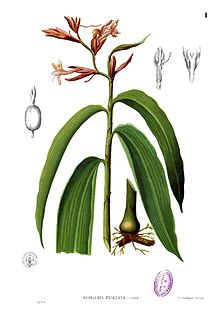Renealmia alpinia is a flowering plant species native to the Americas, where it grows from southern Mexico through much of South America, though not in the Southern Cone.[2] It can also be found on several Caribbean islands.
| Renealmia alpinia | |
|---|---|

| |
| Botanical illustration of R. alpinia from Flora de Filipinas by Francisco Manuel Blanco | |
| Scientific classification | |
| Kingdom: | Plantae |
| Clade: | Tracheophytes |
| Clade: | Angiosperms |
| Clade: | Monocots |
| Clade: | Commelinids |
| Order: | Zingiberales |
| Family: | Zingiberaceae |
| Genus: | Renealmia |
| Species: | R. alpinia
|
| Binomial name | |
| Renealmia alpinia | |
| Synonyms | |
In Quechua it is called misk'i p'anqa (misk'i sweet; honey, p'anqa bract, "sweet bract" or "honey bract").[3][4] The name alludes to R. alpinia's value as a culinary herb, especially for flavoring fish. Among Spanish-speakers this species is known as jenjibre-de-jardin ("garden ginger"). Both jenjibre-de-jardin and ginger (Zingiber officinale) are in the family Zingiberaceae.
Renealmia alpinia is commonly known as mardi gras in Trinidad, where hunters administer it either orally or topically to their hunting dogs to treat a variety of conditions, from sprains to snakebite.[5]
In Suriname it's known as masoesa.[6]
Biochemistry edit
Zhou et al. (1997) of the Virginia Polytechnic Institute and State University identified three diterpenes produced by R. alpinia: 11-hydroxy-8(17),12(E)-labdadien-15,-16-dial 11,15-hemiacetal (1) and 16-oxo-8(17),12(E)-labdadien-15-oic acid (2), which are labdane diterpenes, and 8(17),12(E)-labdadien-15,16-dial (3). The team performed these assays on the basis of reports that R. alpinia may be antipyretic (fever-reducing).[7]
Biogeography edit
In Mexico, wild R. alpinia populations have been found in the southern states of Chiapas, Oaxaca, and Veracruz. It also grows on the Caribbean islands of Dominica, Grenada, Guadeloupe, Martinique, Montserrat, Puerto Rico, St. Kitts, Nevis, Trinidad, and Tobago.
In Central America, it grows in Belize, Costa Rica, Guatemala, Honduras, and Panama.
In South America, it is found in Brazil, Colombia, Ecuador, French Guiana, Guyana, Peru, Suriname, and Venezuela.
References edit
- ^ "Renealmia alpinia". Tropicos. Missouri Botanical Garden. Retrieved 23 June 2013.
- ^ "Renealmia alpinia". Germplasm Resources Information Network. Agricultural Research Service, United States Department of Agriculture. Retrieved 24 June 2013.
- ^ Teofilo Laime Ajacopa (2007). Diccionario Bilingüe: Iskay simipi yuyayk’anch: Quechua – Castellano / Castellano – Quechua (PDF). La Paz, Bolivia: futatraw.ourproject.org.
- ^ "Renealmia alpinia (Zingiberaceae)". National Tropical Botanical Garden. Retrieved 24 June 2013.
- ^ Lans, Cheryl; Harper, Tisha; Georges, Karla; Bridgewater, Elmo (2001). "Medicinal and ethnoveterinary remedies of hunters in Trinidad". BMC Complementary and Alternative Medicine. 1 (10): 10. doi:10.1186/1472-6882-1-10. PMC 60997. PMID 11737880.
- ^ "Zoekresultaten".
- ^ Zhou, B. N.; Baj, N. J.; Glass, T. E.; Malone, S.; Werkhoven, M. C.; van Troon, F.; David, J. H.; Wisse, D. G.; Kingston (December 1997). "Bioactive labdane diterpenoids from Renealmia alpinia collected in the Suriname rainforest". Journal of Natural Products. 60 (12): 1287–93. doi:10.1021/np970233c. PMID 9428162.
External links edit
- Renealmia alpinia at Discover Life. Retrieved 24 June 2013.